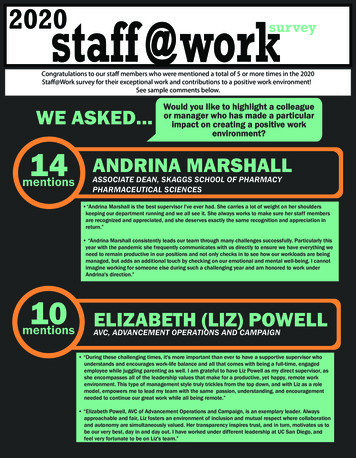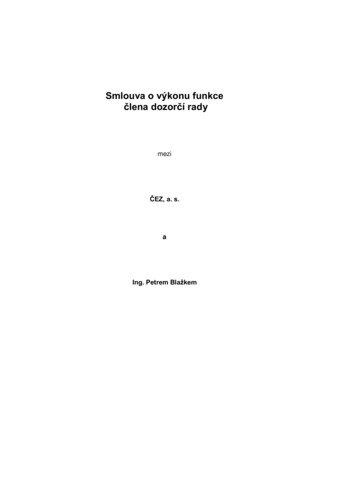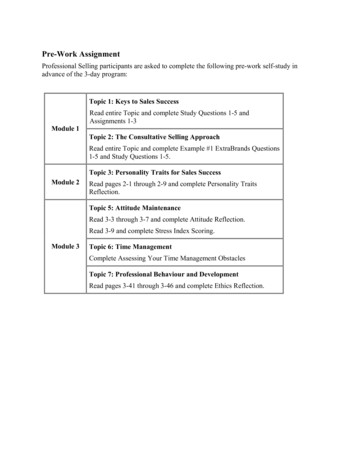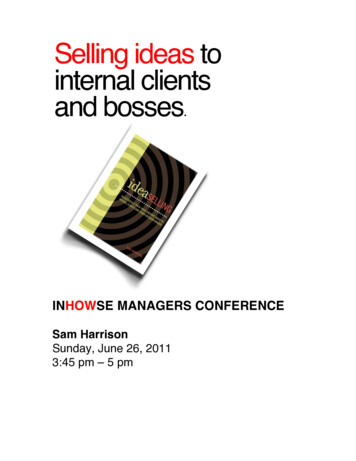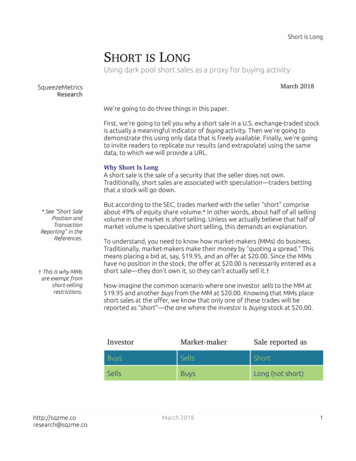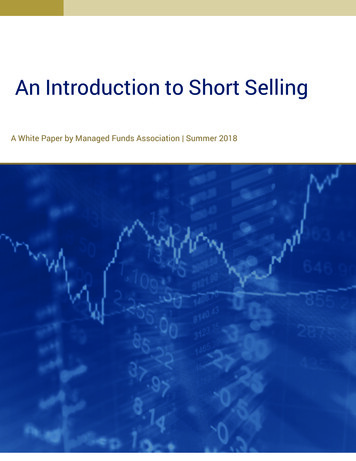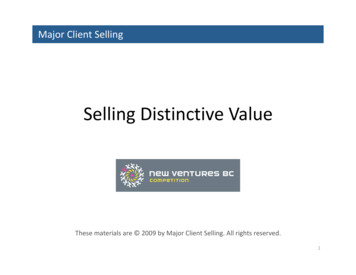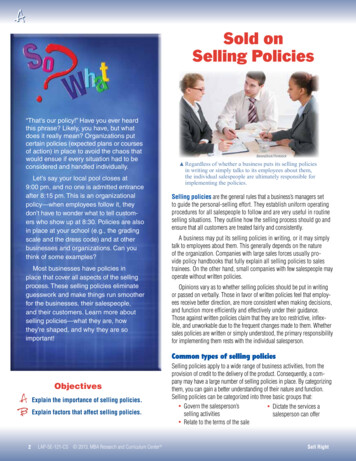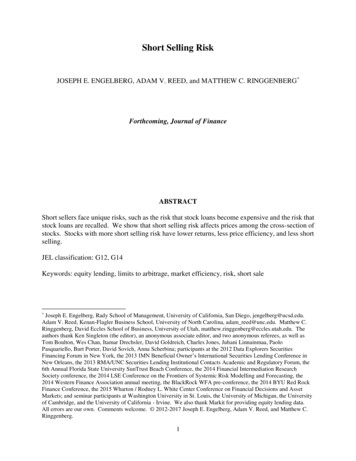
Transcription
Short Selling RiskJOSEPH E. ENGELBERG, ADAM V. REED, and MATTHEW C. RINGGENBERG*Forthcoming, Journal of FinanceABSTRACTShort sellers face unique risks, such as the risk that stock loans become expensive and the risk thatstock loans are recalled. We show that short selling risk affects prices among the cross-section ofstocks. Stocks with more short selling risk have lower returns, less price efficiency, and less shortselling.JEL classification: G12, G14Keywords: equity lending, limits to arbitrage, market efficiency, risk, short sale*Joseph E. Engelberg, Rady School of Management, University of California, San Diego, jengelberg@ucsd.edu.Adam V. Reed, Kenan-Flagler Business School, University of North Carolina, adam reed@unc.edu. Matthew C.Ringgenberg, David Eccles School of Business, University of Utah, matthew.ringgenberg@eccles.utah.edu. Theauthors thank Ken Singleton (the editor), an anonymous associate editor, and two anonymous referees, as well asTom Boulton, Wes Chan, Itamar Drechsler, David Goldreich, Charles Jones, Juhani Linnainmaa, PaoloPasquariello, Burt Porter, David Sovich, Anna Scherbina; participants at the 2012 Data Explorers SecuritiesFinancing Forum in New York, the 2013 IMN Beneficial Owner’s International Securities Lending Conference inNew Orleans, the 2013 RMA/UNC Securities Lending Institutional Contacts Academic and Regulatory Forum, the6th Annual Florida State University SunTrust Beach Conference, the 2014 Financial Intermediation ResearchSociety conference, the 2014 LSE Conference on the Frontiers of Systemic Risk Modelling and Forecasting, the2014 Western Finance Association annual meeting, the BlackRock WFA pre-conference, the 2014 BYU Red RockFinance Conference, the 2015 Wharton / Rodney L. White Center Conference on Financial Decisions and AssetMarkets; and seminar participants at Washington University in St. Louis, the University of Michigan, the Universityof Cambridge, and the University of California - Irvine. We also thank Markit for providing equity lending data.All errors are our own. Comments welcome. 2012-2017 Joseph E. Engelberg, Adam V. Reed, and Matthew C.Ringgenberg.1Electronic copy available at: https://ssrn.com/abstract 2312625
“Some stocks are hard to borrow. Herbalife is not, especially, but it is risky toborrow If Carl Icahn were to launch a tender offer, say, it might get a lot more expensive toshort Herbalife, and the convertible trade would become considerably less fun.”Matt Levine, Former Investment Banker, BloombergView (2014)Short selling is a risky business. Short sellers must identify mispriced securities, borrow sharesin the equity lending market, post collateral, and pay a loan fee each day until the position closes.In addition to the standard risks that many traders face, such as a margin calls and regulatorychanges, short sellers also face the risk of loan recalls and the risk of changing loan fees. Todate, the existing literature has viewed these risks as a static cost to short sellers, and empiricalpapers have shown that static impediments to short selling significantly affect asset prices andefficiency.1 The idea in the literature is simple: if short selling is costly, short sellers may be lesslikely to trade, and, as a result, prices may be biased or less efficient (e.g., Miller (1977),Diamond and Verrecchia (1987), and Lamont and Thaler (2003)).In this paper, we examine the costs of short selling from a different perspective.Specifically, we show that the dynamic risks associated with short selling result in significant1To test the impact of impediments to short selling, existing studies have examined a wide variety of potentialmeasures of short sale constraints including regulatory action (Diether, Lee, and Werner (2009); Jones (2008);Boehmer, Jones, and Zhang (2013); Battalio and Schultz (2011)); institutional ownership (Nagel (2005); Asquith,Pathak, and Ritter (2005)); the availability of traded options (Figlewski and Webb (1993), Danielsen and Sorescu(2001)); and current loan fees (Jones and Lamont (2002); Cohen, Diether, and Malloy (2009)). However, all ofthese are static measures of short sale constraints (i.e., they examine how conditions today constrain short sellers),while we focus on the dynamics of short selling constraints (i.e., we examine how the risk of changing futureconstraints impacts short sellers).1Electronic copy available at: https://ssrn.com/abstract 2312625
limits to arbitrage. In particular, stocks with more short selling risk have lower future returns,less price efficiency, and less short selling.Consider two stocks – A and B – that are identical in every way except for their shortselling risk. Specifically, stock A and stock B have identical fundamentals and they haveidentical loan fees and number of shares available today. However, future loan fees and shareavailability are more uncertain for stock B than for stock A. In other words, there is considerablerisk that future loan fees for stock B will be higher and future shares of stock B will beunavailable for borrowing. Since higher loan fees reduce the profits from short selling andlimited share availability can force short sellers to close their position before the arbitrage iscomplete, a short seller would prefer to short stock A because it has lower short selling risk. Inthis paper, we present the first evidence that uncertainty regarding future short sale constraints isa significant risk, and we show that this risk affects trading and asset prices.The short selling risk we describe has theoretical underpinnings in several existingmodels. For example, in D’Avolio (2002b) and Duffie, Garleanu, and Pedersen (2002), shortselling fees and share availability are a function of the difference of opinions between optimistsand pessimists, and short selling risk emerges as these differences evolve. As noted by D’Avolio(2002), “ a short seller is concerned not only with the level of fees, but also with fee variance.”Accordingly, we focus on the variance of lending fees as our natural proxy for short selling risk.To get the best possible measure of this proxy, we project the variance of lending fees on severalequity lending market characteristics and firm characteristics. We use fitted values from thisforecasting model (ShortRisk) as our measure of short selling risk.22Our results are robust to using alternate measures of short selling risk, including the unconditional historicalvariance of loan fees for each stock. These results are shown in the internet appendix.2Electronic copy available at: https://ssrn.com/abstract 2312625
Using this measure, we examine whether short selling risk affects arbitrage activity. Ifshort selling risk limits the ability of arbitrageurs to trade and correct mispricing, then it shouldbe related to returns, market efficiency, and short selling activity. We find that it is. First, weshow that our short selling risk proxy is related to future returns. A long-short portfolio formedbased on ShortRisk earns a 9.6% annual five-factor alpha. Moreover, in a Fama-MacBeth (1973)regression framework we confirm the return predictability of short selling risk after controllingfor a variety of firm characteristics. In addition, we consider the Stambaugh, Yu, and Yuan(2015) mispricing measure (MISP) and find that MISP’s ability to predict returns is greatestamong stocks with high short selling risk. Thus, higher short selling risk appears to limit theability of arbitrageurs to correct mispricing, and as a result, these stocks earn lower futurereturns.3Next, we test whether increases in short selling risk are associated with decreases in priceefficiency. We examine the Hou and Moskowitz (2005) measure of price delay and find thatshort selling risk is associated with significantly larger price delay, even after controlling forcurrent loan market conditions (Saffi and Sigurdsson (2011)). A one standard deviation increasein ShortRisk is associated with a 9.1% increase in price delay. In other words, the risk of futureshort selling constraints is associated with decreased price efficiency today, independent of shortconstraints that may exist at the time a short position is initiated.3This result is consistent with models of limits to arbitrage. For example, the model in Schleifer and Vishny (1997)predicts that stocks that are riskier to arbitrage will exhibit greater mispricing and have higher average returns toarbitrage.3
Of course, if short selling risk is truly a limit to arbitrage, then we would expect this riskto affect trading activity, especially for trades with a long expected time to completion.4 Ofek,Richardson, and Whitelaw (2004) note that the, “ difficulty of shorting may increase with thehorizon length, as investors must pay the rebate rate spread over longer periods and shortpositions are more likely to be recalled.” To test this prediction, we turn to one of the only caseswhere mispricing and the expected holding horizon of a trade can be objectively measured exante. Specifically, we examine deviations between stock prices and the synthetic stock priceimplied from put-call parity. Ofek, Richardson, and Whitelaw (2004) and Evans et al. (2009)show that deviations between the actual and synthetic stock price often imply that a short sellerwould short sell the underlying stock and purchase the synthetic stock, with the expectation thatthe two prices will converge upon the option expiration date.Accordingly, we measure mispricing using the natural log of the ratio of the actual stockprice to the implied stock price (henceforth put-call disparity) as in Ofek, Richardson, andWhitelaw (2004), and we examine whether short sellers trade less on mispricings when shortselling risk is high and when the option has a long time to maturity. We find that they do. Inother words, arbitrageurs short significantly less when short selling risk is high, and, as a result,there is more mispricing today. Moreover, both of these effects are significantly larger for longhorizon trades.When ShortRisk and days to expiration are at the 25th percentile in our sample, shortvolume is approximately 5.1% below its unconditional mean and put-call disparity today isapproximately 13.9% above its unconditional mean. However, when ShortRisk and days toexpiration are at the 75th percentile in our sample, short volume is 21.7% below its unconditional4We thank an anonymous referee and the editor for suggesting this point.4
mean and put-call disparity today is approximately 149% above its unconditional mean.5 Inother words, higher short selling risk leads to significantly less short selling by arbitrageurs andgreater mispricing today, and longer holding horizons magnify both of these effects.Of course, it is natural to expect that the risks we describe here could be correlated withother well-known predictors of returns. For example, Ang et al. (2006) show that highidiosyncratic volatility is associated with low future returns. We find that all of our results stillhold after controlling for other known predictors of returns, including liquidity and idiosyncraticvolatility (e.g., Ang et al. (2006), Pontiff (2006)).Overall, our results make several contributions. First, and most importantly, we are thefirst paper to show that uncertainty regarding future short selling constraints acts as a significantlimit to arbitrage; we show that higher short selling risk is associated with lower future returns,decreased price efficiency, and less short selling activity by arbitrageurs. We also show thatthese effects are magnified for trades with a long expected holding horizon. In addition, weshow that short selling risk is particularly high when there are extreme returns, indicating thatshort selling risk may have an adverse correlation with returns. Finally, we note that our findingsmay help explain existing anomalies, including the low short-interest puzzle (Lamont and Stein(2004)). We also posit that short selling risk may explain the puzzling fact that short interestdata predict future returns even though short interest is publicly observable. In other words, thefact that short interest data predict returns and is publicly released by the exchanges begs thequestion: why don’t other investors arbitrage away the predictive ability of short interest? Ourresults provide a partial explanation: short selling is risky.5The 25th and 75th percentiles of ShortRisk are 1.54 and 5.38, respectively. The 25th and 75th percentiles of monthsto expiration are 2 and 5 months, respectively.5
The remainder of this paper proceeds as follows: Section I briefly describes the existingliterature, Section II describes the data used in this study, Section III characterizes our findings,and Section IV concludes.I. BackgroundAlthough we consider short sale constraints from a dynamic perspective, a large literaturehas considered these constraints from a static perspective. In this section, we briefly discussexisting work concerning short sale constraints and limits to arbitrage. We then formalize thehypotheses introduced in the beginning of the paper.A. Existing LiteratureOn the theoretical side, multiple papers have argued that short sale constraints can havean economically significant effect on asset prices (e.g., Miller (1977), Harrison and Kreps(1978), Diamond and Verrecchia (1987)). In addition, empiricists have investigated multipleforms of short selling constraints, including regulatory restrictions and equity loan fees.Several papers have analyzed the effect of short sale constraints by examining changes inthe regulatory environment. For example, Diether, Lee, and Werner (2009) examine the effectsof the Reg SHO pilot and find that short selling activity increased when the uptick rule waslifted. Boehmer, Jones, and Zhang (2013) find that the U.S. short selling ban reduced marketquality and liquidity. More broadly, Beber and Pagano (2013) find that worldwide short sellingrestrictions slowed price discovery.The equity loan market also provides an opportunity for researchers to study the impactof short sale constraints. Using loan fees from the equity loan market, Geczy, Musto, and Reed6
(2002) suggest that short selling constraints have a limited impact on well-accepted arbitrageportfolios such as size, book-to-market, and momentum portfolios. Using institutionalownership as a proxy for supply in the equity loan market, Hirshleifer, Teoh, and Yu (2011)examine the relation between short sales and both the accrual and net operating asset anomalies.They find that short sellers do try to arbitrage mispricings, but short sale constraints appear tolimit their ability to arbitrage them away.Several papers abstract away from specific short sale constraints and instead use thegeneral fact that short selling is more constrained than buying to examine possible asymmetriesin long-short portfolio returns. Stambaugh, Yu, and Yuan (2012) examine a variety of anomaliesand find that they tend to be more pronounced on the short side, consistent with the idea thatshort selling is riskier, thereby leading to less short selling by arbitrageurs. In a related paper,Stambaugh, Yu, and Yuan (2015) note that idiosyncratic volatility is negatively related to returnsamong underpriced stocks but is positively related to returns among overpriced stocks. Morerecently, Drechsler and Drechsler (2014) document a shorting premium and show that assetpricing anomalies are largest for stocks with high equity lending fees.Finally, in a recent working paper, Prado, Saffi, and Sturgess (2014) examine the crosssectional relation between institutional ownership, short sale constraints, and abnormal stockreturns. They find that firms with lower levels of institutional ownership and/or moreconcentrated institutional ownership tend to have higher equity lending fees, and these firms alsotend to earn abnormal returns that are significantly more negative.B. Hypothesis Development7
In this paper, we empirically examine the risk that future lending conditions might moveagainst a short seller. In what follows, we use existing theory to motivate our empiricalmeasures and develop testable predictions.Several extant papers lend support for the idea that short selling risk will impact arbitrageactivity. Mitchell, Pulvino, and Stafford (2002) empirically examine arbitrage activity forsituations in which the market value of a company is less than its subsidiary and find that shortselling risk can limit arbitrage activity. They specifically discuss short selling risk, noting that,“The possibility of being bought-in at an unattractive price provides a disincentive forarbitrageurs to take a large position.” Consistent with this, D’Avolio (2002b) develops atheoretical model of equilibrium in the lending market and finds that, “In a multiperiod setting, ashort seller is concerned not only with the level of fees, but also with fee variance. This isbecause current regulations stipulate that lenders maintain the right to cancel a loan at any timeand hence preclude most large institutions from providing guaranteed term loans.”In D’Avolio (2002b), a short seller can respond to changes in lending market conditionsby, “buying back the shares and returning them to the lender, or re-establishing the short at thehigher loan fee.” Thus, the model shows that share recalls and loan fee increases are twomanifestations of the same underlying event: changes in lending conditions that leave the loanmarket temporarily out of equilibrium. As a result, recalls and fee changes are not independentrisks: a share recall can be seen as an extremely high loan fee. Consistent with theoreticalmodels, we develop two empirical measures of short selling risk in Section II, below. We viewour measures as proxies for the risk of short sale constraints that arise from changing lendingmarket conditions.8
The model in D’Avolio (2002b) also suggests that lending market conditions will impactarbitrage activity.6 Specifically, the model shows that short selling is less attractive toarbitrageurs when short selling risk is high.7 While D’Avolio (2002b) does not explicitly modelthe short seller’s demand function in the multiperiod case with short selling risk, a related modelin D’Avolio and Perold (2003) shows that short sellers will be less likely to trade if theprobability of binding future short sale constraints is high. Furthermore, this model also suggeststhat the expected trading horizon will matter; D’Avolio and Perold (2003) show that shortsellers’ willingness to trade will be low when, “the expected price correction is unlikely to occurin the near future.”Accordingly, we use these results to generate several testable predictions regarding theimpact of short selling risk. First, we hypothesize that high short selling risk will be associatedwith less trading by short sellers, consistent with the predictions in D’Avolio (2002 and 2002b)and D’Avolio and Perold (2003). Second, consistent with models of limits to arbitrage (e.g.,Schleifer and Vishny (1997)), we hypothesize that stocks with higher arbitrage risk, in this caseshort selling risk, will exhibit greater mispricing. Third, as suggested by Ofek, Richardson, andWhitelaw (2004) and D’Avolio and Perold (2003), we hypothesize that the impact of shortselling risk will be greater for trades with a longer expected holding horizon. Finally, we note6The model in Stambaugh, Yu, and Yuan (2015) can generate similar predictions. Specifically, if we introduce astochastic loan fee to the model, the solution to the utility maximization problem shows that portfolio weights aredecreasing in the variance of loan fees, and, as a consequence, mispricing is an increasing function of the variance ofloan fees. A theoretical derivation of this result is available from the authors upon request.7The model focuses primarily on a one-period case, in which equity lending conditions are known with certainty.However, the paper includes a multiperiod extension that discusses short selling risk.9
that the existing literature finds that short selling leads to improved price efficiency (Saffi andSigurdsson (2011)). This generates a fourth prediction: we hypothesize that stocks with moreshort selling risk will have less price efficiency.In sum, we hypothesize that arbitrageurs may be less willing to short when future lendingconditions are more uncertain and when the expected holding horizon is longer. As a result,short selling risk may impact returns, price efficiency, and trading volume.II. DataTo test the hypotheses discussed above, we combine daily equity lending data with datafrom the Center for Research in Security Prices (CRSP), Compustat, the NYSE Trade and Quote(TAQ) database, and OptionMetrics, as discussed in detail below.A. Equity Lending DataThe equity lending data used in our analyses come from Markit. The data are sourcedfrom a variety of contributing customers including beneficial owners, hedge funds, investmentbanks, lending agents, and prime brokers; the market participants that contribute to this databaseare believed to account for the majority of all equity loans in the U.S. The initial databaseincludes information on a variety of overseas markets and share classes. However, we excludedata on non-U.S. firms, ADRs, and ETFs, and we drop firms that have a stock price below 5 ora market capitalization below 10 million; we also require each firm to have at least 50 nonmissing days each year to be included in the sample. The resulting database includesapproximately 220,000 observations at the firm-month level for 4,500 U.S. equities over the 5.5year period from July 1, 2006 through December 31, 2011.10
The equity lending database includes several variables from the equity loan market. Ofprimary interest are shares borrowed (Short Interest), the active quantity of shares available to beborrowed (Loan Supply), the active utilization rate (Utilization), the weighted average loan feeacross all shares currently on loan (Loan Fee), the weighted average loan fee for all new loansover the past day (New Loan Fee), and the weighted average number of days that transactionshave been open (Loan Length). A stock’s Loan Supply represents the total number of shares thatinstitutions are actively willing to lend, expressed as a percentage of shares outstanding. TheUtilization is the quantity of shares loaned out as a percentage of Loan Supply. Finally, LoanFee, often referred to as specialness, is the cost of borrowing a share in basis points per annum.INSERT TABLE I ABOUT HEREPanel A of Table I contains summary statistics for the equity lending database. For thetypical firm, approximately 18% of outstanding shares are available to be borrowed and around4% of shares outstanding are actually on loan at any given point. The median loan fee is only 11basis points per annum; however, it is well known that loan fees exhibit considerable skewness,as indicated by the mean of 85 basis points and the 99th percentile of 1,479 basis points. Themedian loan is open for approximately 65 days, highlighting the fact that short sellers often holdtheir position open for several months and thus are exposed to loan fee changes. Of course, themagnitude of loan fees may seem small when compared to other risks faced by arbitrageurs,especially when looking at the median loan fee of 11 bps. However, the 99th percentile of loanfees in our sample is 14.79% per year; as discussed in Kolasinski, Reed, and Ringgenberg(2013), loan fees can increase to levels that significantly decrease the profitability of nearly anytrade. Moreover, in Panel C we examine the within-firm (i.e., time-series) properties of lendingmarket conditions. We calculate the mean, median, 1st, and 99th percentiles of loan fees and11
utilization by firm, and then display the cross-sectional mean of these summary statistics. Themean of the 99th percentile of loans fees is 301 bps points while the 1st percentile is 7 basispoints; in other words, the average stock experiences dramatic variation in its loan fees overtime.In addition to the equity lending data discussed above, we use publicly available datafrom the SEC website to add information on failures to deliver. Failures to deliver occur whenshares are not delivered by the standard three-day settlement date (often referred to as t 3); theSEC provides the aggregate net balance of shares that failed to be delivered on each date. Thedata provide information on the cumulative number of shares that have not been delivered, whichdoes not necessarily indicate the number of new failures on any given date, as some failedpositions may persist for several days. If the net balance of failed shares is below 10,000 for agiven firm, the SEC does not release any information and we record a balance of zero failures forthat day. As shown in Table I, failures to deliver (Qty. Failures) are relatively rare with a meanof 0.36% of shares outstanding and a median of 0.00% of shares outstanding.B. Data CompilationWe match the equity lending database at the firm-month level with information fromCRSP, Computstat, TAQ, and OptionMetrics. From CRSP, we add closing stock prices, closingask and bid prices, shares outstanding, volume, and monthly returns, including dividenddistributions. From TAQ, we add short sales volume for each stock using the regulation SHOdatabase.8 From OptionMetrics, we add option best bid and offer prices, expiration dates, andstrike prices. As in Ofek, Richardson, and Whitelaw (2004), we drop contracts with bid-ask8We exclude all canceled and invalid trades in TAQ.12
spreads greater than 50%, absolute value of log moneyness greater than 0.5, or non-positiveimplied volatility. To minimize the impact of illiquidity, we focus on contracts with greater than6 days but less than 181 days to maturity. From Compustat we add the natural log of the marketto-book ratio. We define book equity as total shareholder equity minus the book value ofpreferred stock plus the book value of deferred taxes and investment tax credit. If totalshareholder equity is missing, we calculate it as the sum of the book value of common andpreferred equity. If all of these are missing, we calculate shareholder equity as total assets minustotal liabilities. Finally, we add NYSE breakpoints and Fama and French (2015) factors fromKenneth French’s website and we add the Stambaugh, Yu, and Yuan (2015) mispricing scorefrom Robert Stambaugh’s website. Panel B of Table I contains summary statistics for the CRSPdata. The mean market capitalization for the firms in our sample is 3.77 billion and the medianmarket capitalization is 0.46 billion.C. Measures of Short Selling RiskMotivated by the theoretical results discussed in Section I.B, we define a measure of shortselling risk (ShortRisk). The measure is motivated by D’Avolio (2002b), who notes that, “ ashort seller is concerned not only with the level of fees, but also with fee variance.” Consequently,we calculate the natural log of the variance of the daily Loan Fee for each stock over the past 12months and we project this variable on a variety of lagged firm and lending market characteristics.The predicted values of the model, which we label ShortRisk, represents a trader’s estimate ofshort selling risk given available information.In our forecasting regression, we appeal to the prior literature in our choice of predictivevariables. Because Aggarwal, Saffi, and Sturgess (2015) demonstrate the importance of utilization13
in the equity loan market, we consider prior loan utilization as a key forecasting variable.Moreover, because Geczy, Musto, and Reed (2002) demonstrate the usefulness of prices from newloans, we also consider the loan fees from new loans. Specifically, we use four equity lendingmarket characteristics: (i) VarNewFee, (ii) VarUtilization, (iii) TailNewFee, and (iv)TailUtilization. VarNewFee is defined as the variance of loan fees for new equity loans andVarUtilization is defined as the natural log of the variance of the ratio of equity loan supply to loandemand (i.e., utilization). We also define two tail risk versions of these variables, TailFee andTailUtilization, which proxy for the likelihood of extreme loan fees and extreme utilization,respectively. Specifically, we define TailNewFee and TailUtilization as the 99th percentile of anormal distribution using the trailing annual mean and variance of loan fee and utilization,respectively.9We also consider a number of potentially relevant firm characteristics, including a numberof characteristics that are worth noting in this context. Perhaps most important are lagged valuesof fee risk, the number of fails to deliver, an indicator variable for stocks which had an IPO withinthe last 90 days, and an indicator variable for stocks with listed options.INSERT TABLE II ABOUT HEREThe results from the following model are presented in Table ��,𝑡 1 ) α 𝛽1 𝑉𝑎𝑟𝑁𝑒𝑤𝐹𝑒𝑒𝑖,𝑡 𝛽2 ��𝑛𝑖,𝑡 𝛽3 𝑇𝑎𝑖𝑙𝑁𝑒𝑤𝐹𝑒𝑒𝑖,𝑡 𝛽4 ��𝑜𝑛𝑖,𝑡 FEi FirmCharacteristics 𝜀𝑖,𝑡 1 ,9(1)Our measures are based on the well-known value-at-risk measure and are calculated on each date for each stock asthe mean of loan fee (utilization) 2.33 variance of loan fees (utilization), where the mean and variance aremeasured over the prior 250 trading days.14
where FEi indicates a firm fixed effect and FirmCharacteristics is a vector of time-varying firmcharacteristics. We display t-statistics calculated using standard errors clustered by firm and date.Although our main interest in this section is to find an accurate forecast of short selling risk, theresults here shed some light on the underlying determinants of short selling risk. For example, thenegative and statistically significant coefficient on the option indicator variable suggests that shortselling risk is lower for stocks with traded options. Similarly, the positive and statisticallysignificant coefficients on the dividend indicator and the
Short sellers face unique risks, such as the risk that stock loans become expensive and the risk that stock loans are recalled. We show that short selling risk affects prices among the cross-section of stocks. Stocks with more short selling risk have lower returns, less price efficiency, and less short selling. JEL classification: G12, G14 Keywords: equity lending, limits to arbitrage, market .
